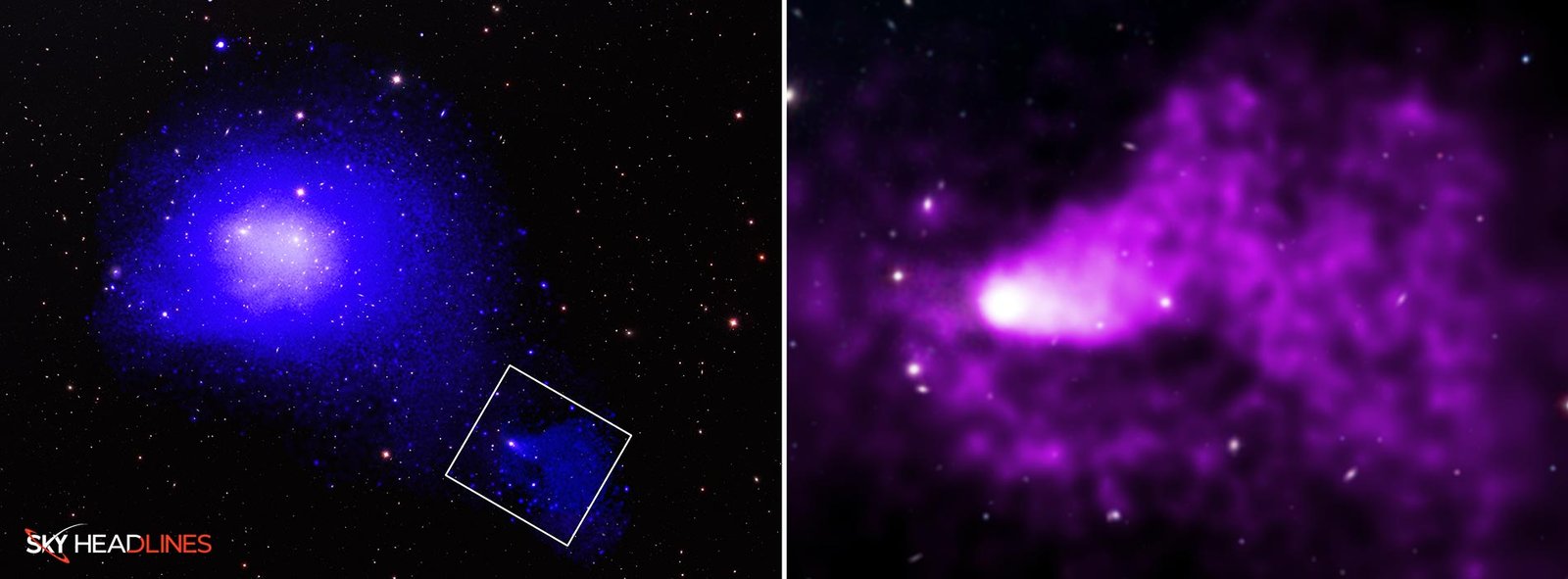In a groundbreaking revelation, astronomers have utilized NASA’s Chandra X-ray Observatory to unveil the extraordinary phenomenon of “cosmic collisions” within the immense realm of the universe. The observation reveals that NGC 4839, a conglomerate of galaxies, is presently engaged in a collision course with the awe-inspiring Coma galaxy cluster, resulting in the creation of an enormous tail composed of intensely heated plasma.
This momentous discovery provides valuable insights into the growth of galaxy clusters, which are among the largest entities in existence. These new findings, focusing on cosmic collisions, were recently presented at the American Astronomical Society’s 242nd meeting, deepening our understanding of the tremendous width and extent of these cosmic formations. When galaxies come together through the force of gravity, they give rise to smaller gatherings called “galaxy groups” or larger collections called “galaxy clusters.”
Galaxy groups are typically made up of 50 galaxies, whereas clusters might contain hundreds or even thousands of individual galaxies. These cosmic entities are predominantly composed of hot, diffuse gas observed most effectively through X-ray imaging. Despite their thin and sparse nature, these superheated gas reservoirs play a pivotal role in understanding the dynamics of galaxy clusters and groups.
NGC 4839 and the Coma Cluster:
NGC 4839, located on the periphery of the massive Coma galaxy cluster, lies approximately 340 million light-years away. As NGC 4839 advances towards the core of the Coma cluster, its hot gas interacts with the surrounding gas, giving rise to the formation of a prominent tail. This tail, stretching behind NGC 4839, serves as a visible manifestation of the intricate processes occurring within this cosmic collision.
Astronomers skillfully obtained a remarkable X-ray perspective of the Coma galaxy cluster by utilizing ESA’s XMM-Newton satellite, along with optical information sourced from the Sloan Digital Sky Survey. Within this composite image, NGC 4839 can be seen in the lower right corner. A closer examination using the Chandra X-ray Observatory revealed the brightest galaxy in the group and the densest gas concentrated near the head of NGC 4839’s tail, which extends towards the right. This tail, measuring a staggering 1.5 million light-years in length, represents the broadest ever recorded behind a group of galaxies.
Significance of the Tail:
The brightness of the tail provides astronomers with a unique opportunity to investigate the properties of the gas before it merges with the vast reservoir of hot gas in the Coma Cluster, eventually becoming too faint to observe. By studying the gas within NGC 4839’s tail, scientists can gain valuable insights into the physical processes and dynamics at play within these cosmic collisions.
Shock Wave and Turbulence:
Through Chandra data analysis, researchers identified a shock wave, akin to the sonic boom of a supersonic jet, indicating that NGC 4839 is hurtling through the Coma cluster at a staggering speed of approximately 3 million miles per hour. Additionally, scientists investigated the turbulence within the tail’s gas and found it to be relatively minor, suggesting modest heat conduction within NGC 4839.
Kelvin-Helmholtz Instabilities:
Researchers also detected the presence of Kelvin-Helmholtz instabilities on one side of the tail. These unusual structures, commonly observed in various celestial and terrestrial phenomena, arise from differences in the speed of flowing layers of gas or fluid. The occurrence of Kelvin-Helmholtz instabilities in NGC 4839 suggests either a weak magnetic field or a viscous nature of the gas within the tail.
Implications of the Discovery:
Previous observations estimated the length of NGC 4839’s tail to be at least one million light-years. However, the latest Chandra data has revealed an astonishing new record-breaking length of 1.5 million light-years. This significant increase in the estimated size of the tail highlights the dynamic nature of galactic interactions and the need for continuous exploration and observation to deepen our understanding of these cosmic phenomena.
Conclusion:
The collision between NGC 4839 and the Coma galaxy cluster has unveiled a truly awe-inspiring spectacle in the vastness of space. The discovery of the massive tail extending over 1.5 million light-years behind NGC 4839 has provided astronomers with a unique opportunity to study the gas dynamics and physical processes associated with galactic collisions. The extensive research conducted by NASA’s Chandra X-ray Observatory has yielded invaluable understanding regarding the formation and evolution of galaxy clusters, shining a beacon of illumination on the fundamental forces that sculpt the colossal structures within our vast universe. The scientific community eagerly awaits future insights that will enhance our understanding of the cosmos we inhabit as we continue to unravel the secrets of these cosmic encounters.





